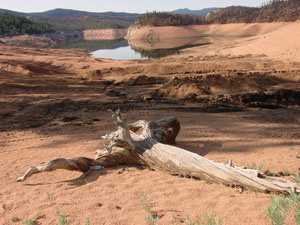
Drought Response
Denver Water’s proactive efforts take a holistic approach that includes planning for all water shortage events. Water shortages can occur many ways including from drought, curtailment of water supplies or an emergency in our water distribution system. Regardless of the cause, Denver Water has processes in place to respond appropriately to a water shortage event.
All decisions pertaining to water shortage response are made by the Denver Water Board of Water Commissioners. The Board uses Chapter 15 of the Denver Water Operating Rules for guidance in their decision-making process. The goal of the Board’s response is to maintain the health, safety and economic vitality of the community to the extent possible in the face of water shortages.
Drought is the most frequent water shortage event for the 1.5 million people Denver Water serves. The weather in Denver Water’s collection system and service area constantly fluctuates, but it’s typically very dry.
Denver receives an average of 15 inches of precipitation each year, which is about a fourth of the precipitation a tropical city such as Miami receives.
We’ve also experienced several severe droughts in the past that have challenged our water system and depleted our supply.
With such a dry climate, it’s always important to use water wisely. To assist our customers in their efficiency efforts, Denver Water has created an Efficiency Plan.
You can also keep updated on statewide drought conditions through the U.S. Drought Monitor.
Stages of Water Shortage Response
Denver Water’s Water Shortage Response Implementation Plan details water shortage indicators, response tools and response actions. Denver Water’s primary response to water shortage is to restrict customers’ water use so supplies will last as long as possible and be available for the most essential uses.
Denver Water’s annual watering rules are enforced May 1 to Oct. 1 every year, regardless of conditions.
Additionally, four stages of response have been identified based on various water shortage indicators such as:
- Current and projected supply reservoir contents;
- Watershed characteristics in the Colorado and South Platte River basins such as temperature, precipitation, snowpack, streamflow, wind, and soil moisture;
- Water use, including projected water use;
- Weather forecasts;
- Actions taken by local, regional and/or state governments or water suppliers regarding water use;
- Drought response actions taken by state water officials;
- Water availability conditions and/or drought conditions in the Colorado and South Platte River basins; and
- A failure or emergency in the Water System.
These four responses are:
- Water Shortage Watch: Increased communication and outreach; possible water use restrictions as provided by contract.
- Stage 1 Water Shortage: Mandatory water use restrictions, including limited outdoor watering.
- Stage 2 Water Shortage: Increased mandatory water use restrictions, including certain prohibitions on outdoor watering.
- Stage 3 Water Shortage: Rationing of water.
